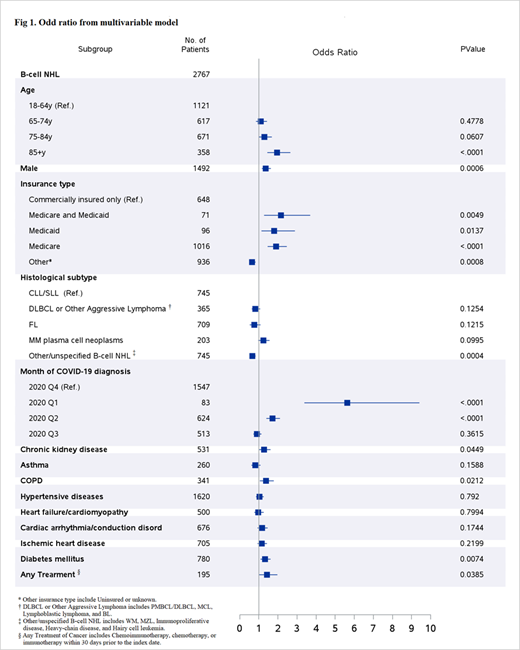Abstract
Introduction
COVID-19 poses a serious concern for mB-cell NHL patients given their advanced age, high burden of comorbidities, and immune dysfunction. Limited by smaller sample sizes during the early period of the COVID-19 pandemic, previous studies were unable to thoroughly evaluate the impact of COVID-19 on patients with mB-cell NHL 1,2. We aim to describe demographics and clinical characteristics, outcomes, and risk factors associated with death and other severe outcomes among COVID-19 patients with mB-cell NHL in a large US nationwide database.
Methods
This retrospective cohort study was conducted using the Optum EHR database, comprising data from an integrated network of ambulatory and hospital care providers across the US. Patients with COVID-19 (diagnosis code of U07.1, U07.2, or a positive result of SARS-Cov-2 virus PCR or antigen tests) between Feb. 1, 2020 and Jan 7, 2021 (index date) and mB-cell NHL diagnosis prior to the COVID-19 diagnosis were included. Patients were excluded if they were under 18 years of age, had missing age or sex, or had <1year continuous eligibility prior to their index date (pre-index period). All baseline characteristics, including demographics and comorbidities, were determined during the one-year pre-index period. Severe outcomes, including death, hospitalization, ICU admission, and acute respiratory insufficiency (ARI), were evaluated within 30 days post-index date. Multivariable logistic regression was conducted to identify variables independently associated with severe outcomes.
Results
Among 2,767 patients with mB-cell NHL who were infected with SARS-CoV-2 between Feb. 1, 2020 and Jan. 7, 2021 (mean age±SD: 67.9 years±14.7, 53.9% male), majority were white (73.9%), followed by African American (10.9%), Hispanic (6.9%), and Asian (1.2%). The most common subtypes of mB-cell NHL were chronic lymphocytic leukemia/small lymphocytic lymphoma (26.9%), multiple myeloma (22.4%), diffuse large B-cell lymphoma (13.2%), and follicular lymphoma (7.3%). Of these patients, 93.4% have at least one comorbidity. The most common comorbidities were hypertension (58.5%), neurological disease (49.4%), diabetes (28.2%), ischemic heart disease (25.5%), cardiac arrhythmia/conduction disorders (24.4%), chronic kidney disease (CKD, 19.2%), heart failure/cardiomyopathy (18.1%), and COPD (12.3%).
Overall, 960 patients (34.7%) developed severe outcomes, among which, 847 patients (30.6%) were hospitalized, 214 patients (7.7%) were admitted to the ICU, 201 patients (7.3%) experienced ARI, and 220 patients (8.0%) died. Multivariable logistic regression showed that increased odds of severe outcomes were independently associated with older age (85+ years vs. <65 years; adjusted odds ratio [OR], 2.0; 95% CI, 1.4-2.7), male gender (OR, 1.4; 95% CI, 1.1-1.6), insurance coverage with Medicaid (OR, 1.8; 95% CI, 1.1-2.9) and/or Medicare (vs. commercial only; OR, 1.9; 95% CI, 1.5-2.5), infected during the first quarter (OR, 5.6; 95% CI, 3.4-9.4) or second quarter of 2020 (vs. fourth quarter of 2020; OR, 1.7; 95% CI, 1.4-2.1), having CKD (OR, 1.3; 95% CI, 1.0-1.6), COPD (OR, 1.4; 95% CI, 1.0-1.8), diabetes (OR, 1.3; 95% CI, 1.1-1.6), and receiving active treatment for NHL (OR, 1.4; 95% CI, 1.0-2.0) within 30 days prior to COVID-19 diagnosis (Figure).
Conclusions
This study demonstrated key demographic and clinical characteristics associated with severe outcomes among COVID-19 patients with mB-cell NHL using one of the largest nationwide databases. Risk factors for severe outcomes identified in the general population, such as older age, male gender, and having certain underlying medical conditions were also identified in this study. In addition, COVID-19 infection occurring earlier in the pandemic and receiving active NHL treatments were associated with severe outcomes. These latter two observations might reflect the improvement in patient management during the latter period of the pandemic and that active mB-cell NHL disease and treatment rendered an increased risk of severe outcomes in COVID-19 patients with mB-cell NHL. These insights highlight the importance of utilizing demographic, clinical and treatment information to estimate the risk for severe outcomes, whereas prospective studies focusing on optimal COVID-19 management are required to identify specific actions that can be taken to improve outcomes of COVID-19 in patients with mB-cell NHL.
Yue: Joule: Current Employment. Hallett: AbbVie: Current Employment. Liu: AbbVie: Current Employment. Iyengar: AbbVie: Current Employment. Basa: AbbVie: Current Employment. Yang: AbbVie: Current Employment.


